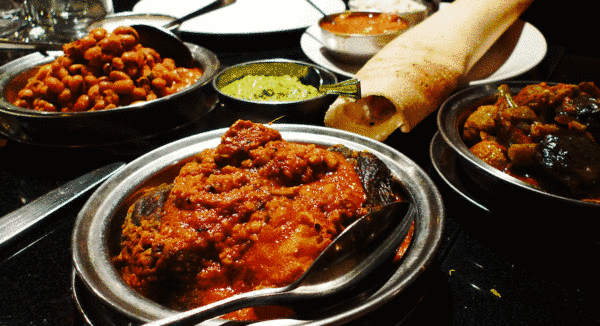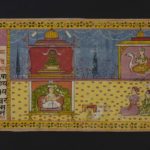Article: Five ‘fundamental vows’
There are five vows that put key Jain beliefs into practice, which are therefore often called ‘fundamental’ vows. All Jain sects recognise that these vows summarise the teachings of Mahāvīra, the 24th Jina and thus the five ‘fundamental’ vows have formed part of the practice of Jainism from the earliest times.
Sources indicate that it has always been accepted that the ‘absolute’ vows are too demanding for most people. Thus there are two versions of the vows, for mendicants and lay people, which are more or less rigorous.
The mendicant vows are called the five mahā-vratas or ‘great vows’. They are a central element in the initiation of new monks and nuns, who mark their passage into mendicancy by making these vows. Carefully observing these lifelong ‘absolute’ vows is a vital element in being a ‘perfect ascetic’.
Lay Jains may take ‘limited’ versions of the fundamental vows. The aṇu-vratas – ‘lesser vows’ – can be observed within secular life, allowing devotees to both meet their family responsiblities and practise Jain beliefs. Keeping the lesser vows is the foundation for becoming a ‘perfect lay Jain’, which is just as important within Jainism as the ideal ascetic. Even so, it is very unusual for contemporary Jains to take the aṇu-vratas. The establishment of the Anuvrat movement in 1949 is the best example of mendicant orders trying to reconcile tradition with contemporary life.
Vows or vratas are very important elements of Jainism, for both mendicant and lay Jains. These vows may be ‘vows of restraint’, meaning that the Jain makes a solemn resolution to not do something, or may involve doing something in particular.
Jains take vows in order to make spiritual progress. The eventual goal of Jainism is the soul‘s liberation from the cycle of rebirth. Most souls remain trapped in the cycle of birth for numerous lifetimes because of the karma bound to them. A soul that is perfect – without any karma – is liberated and can ascend to the top of the universe. Keeping vows eliminates karma because it is a kind of asceticism – tapas. The five fundamental vows are the hardest to live by, especially the absolute mendicant vows. The path to spiritual emancipation is accepted as being very arduous, so Jains admire and honour those who make vows, particularly those who become monks and nuns.
‘Fundamental vows’
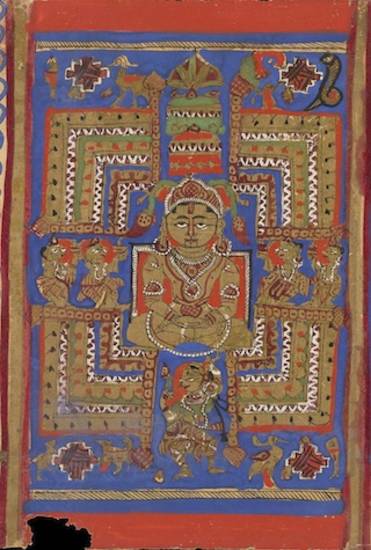
Mahāvīra preaching to his universal gathering
Image by Wellcome Trust Library © Wellcome Library, London
The five principal vows of the Jain faith are:
- non-violence – ahiṃsā
- truth – satya
- non-stealing – acaurya or asteya
- celibacy – brahmacarya
- non-attachment or non-possession – aparigraha.
These vows are ‘absolute’ for the mendicant. Lay people may treat these as ‘absolute’ for particular periods of time or for a certain purpose.
The vows are linked to self-control, which is vital for the total detachment from the world that is required to destroy karma. Jains believe that only by annihilating karma can a soul develop spiritually enough to reach liberation from the cycle of birth.
Both Śvetāmbaras and Digambaras recognise this set of five prescriptions as forming the heart of Mahāvīra’s teachings. In one of the earliest Śvetāmbara sources, the Ācārānga-sūtra, they follow the narration of Mahāvīra’s career and are presented as an outcome of his attainment of omniscient knowledge:
Then when the Venerable Ascetic Mahāvīra had reached the highest knowledge and intuition, he reflected on himself and the world: first he taught the law to the gods, afterwards to men. The Venerable Ascetic Mahāvīra endowed with the highest knowledge and intuition taught the five great vows, with their clauses [and] the six classes of lives.
Ācārānga-sūtra II.15
translation by Jacobi, 1884: 202.
Two versions
These are two versions of these fundamental vows, both of which are voluntary and lifelong. Jain monks and nuns make the ‘absolute’ vows while lay people may decide to take the ‘limited’ or ‘lesser’ set of vows.
Mahā-vratas
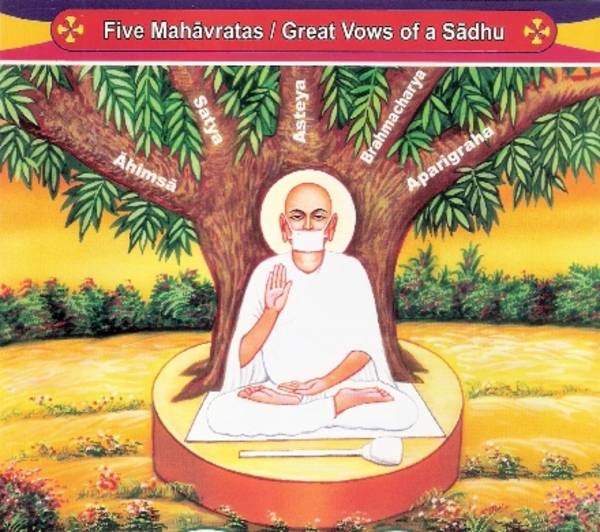
‘Five Great Vows’
Image by Shree Diwakar Prakashan © public domain
As part of their initiation into the mendicant life, monks and nuns take the five mahā-vratas or ‘great vows’. The vows are observed mentally and physically. Mendicants must also not get involved directly or indirectly in other people’s breaches of the vows.
The mendicant vows are ‘absolute’ because they do not admit any softening or dilution. Monks and nuns must keep these vows absolutely or they fail in them.
Jain ascetics observe these vows in three ways, namely in:
- mind – manas
- speech – vāc
- action – kāya, literally ‘body’.
These aspects of the vows apply to both the mendicants’ own behaviour and any indirect involvement or implication in others’ actions. Therefore Jain mendicants also resolve not to:
- cause or encourage anybody else to sin by breaking vows in any of these three ways
- approve of anybody who would transgress in these ways.
Making the vows
At the time of religious initiation – dīkṣā – a monk or nun pronounces the vows in front of his or her religious teacher. Among Śvetāmbara monastic orders, he or she recites them as they have been stated in the Daśavaikālika-sūtra. This canonical scripture, in Ardhamāgadhī Prakrit, is the first these mendicants learn by heart as part of their curriculum:
The first great vow, o my Master, (concerns) the abstention from injuring any (living) being. O my master, I renounce all injury against any being, be it subtle or gross, (spontaneously) moving or immovable. I (shall myself) not injure any living being, nor cause it to be injured by others, nor allow others who injure it, to do so. As long as I live, I (shall) not perform an injury against a being in (one of the) three ways, viz. with mind, speech and body, nor (shall) I cause (another person) to perform (it), nor (shall) I allow another person who performs it, to do so. (On the contrary,) I (shall) confess (such an act and) blame (and) censure (myself when I have performed it), and abandon myself (in repentance). O my Master, I have taken the first great vow, (concerning) the abstention from injuring a living being.
Now follows, o my Master, the second great vow, (concerning) the abstention from false speech. O my master, I renounce all false speech, may it arise from anger, greed, fear, or mirth. I (shall myself) not speak falsely, nor cause false speech to be spoken by others, nor allow others who speak it, to do so. As long as I live, I (shall) not speak falsely (etc., as above). O my Master, I have taken the second great vow, (concerning) the abstention from false speech.
Now follows, o my Master, the third great vow, (concerning) the abstention from taking that which is not given. O my Master, I renounce all taking that which is not given, whether in a village or in a town or apart from human dwellings, be the object little or much, small or big, living or lifeless. I (shall) not take (myself) that which is not given, nor cause it to be taken by others, nor allow others who take it, to do so. As long as I live, I (shall) not take that which is not given (etc., as above). O my Master, I have taken the third great vow, (concerning) the abstention from taking that which is not given.
Now follows, o my Master, the fourth great vow, (concerning) the abstention from sexual acts. O my Master, I renounce every sexual act, be it connected with gods, human beings, or animals. I (shall myself) not perform a sexual act, nor cause it to be performed by others, nor allow those who perform it, to do so. As long as I live, I (shall) not perform a sexual act (etc., as above). O my Master, I have taken the fourth great vow, (concerning) the abstention from sexual acts.
Now follows, o my Master, the fifth great vow (concerning) the abstention from property. O my Master, I renounce all property, be it little or much, small or big, living or lifeless. I (shall myself) not acquire property (etc., as above). O my Master, I have taken the fifth great vow, (concerning) the abstention from property.
Daśavaikālika-sūtra, chapter 4
translation by Schubring, 1932: 84–85 = 1977: 202–203.
As in other religious traditions, the phrasing is negative – to abstain from this or that wrong behaviour. But it should not be understood as encouraging inaction. Rather, this is a way of expressing the ideas strongly.
Images of the great vows
Keeping these ‘great vows’ is an important element in trying to be the ‘perfect ascetic’, who follows the rules set out in scriptures and other texts on monastic conduct. By following the rules flawlessly, the mendicant makes good spiritual progress, moving further up the ‘scale of perfection’ towards final liberation.
Thus the great vows are seen as extremely valuable. This is stated in comparisons and parables.
For instance, in the second Aṅga of the Śvetāmbara canon, they are compared to ‘precious things … worn by men of princely rank’ (Sūtrakr̥tānga 1.2.3.3).
A well-known parable is in the sixth Aṅga, the Jñāta-dharmakathānga, where the five great vows are equated with five grains of rice. A man entrusts five rice grains to each of his four daughters-in-law, who act in different ways. The conclusion of the parable explains what happens to monks who behave in the same way as one or the other of the four women. This is given in the table.
|
Women and the five rice grains |
Behaviour of monks |
|---|---|
|
Ujjhiyā throws them away, treating them as unimportant since there are many more grains in the house granary |
The mendicant who abandons the five great vows will be blamed and wander in the cycle of rebirths |
|
Bhogavaiyā eats them |
The mendicant who does not keep them will be blamed and wander in the cycle of rebirths |
|
Rakkhiyā keeps them carefully |
The mendicant who keeps the vows will be respected |
|
Rohiṇī makes arrangements to have them sown and, when the monsoon comes, they yield a fruitful crop. She does this for five successive years |
The mendicant who has cultivated these vows will be respected and will cross the ocean of rebirths, like Rohiṇī |
The importance and relevance of the story in practice is supported by literary evidence that it should be told by the presiding ascetic at the monastic initiation ceremony – dīkṣā. An example is the 14th-century Vidhi-mārga-prapā, a manual written by Jinaprabha-sūri of the Kharatara-gaccha order (Dundas 2002: 158).
Aṇu-vratas
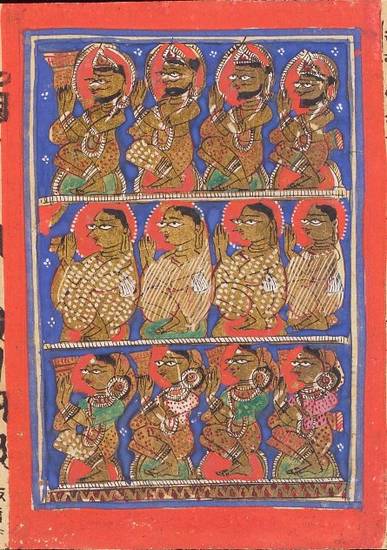
Fourfold community
Image by Wellcome Trust Library © Wellcome Library, London
Lay Jains cannot reach salvation because they do not perform asceticism to the same degree as monks and nuns. However, they can take the aṇu-vratas – ‘lesser vows’ – which are adapted to be practised within the life of the householder and are thus less taxing. Even so, they are very difficult and are a key part of the concept of the ‘perfect lay Jain’.
The motive behind the aṇu-vratas is to minimise behaviour that may harm:
- other living beings
- the individual, by hindering spiritual development.
A lay Jain who makes these resolves not to:
- do any forbidden thing with mind, speech and body – kṛta
- cause harm to other living beings – kārita
- approve of such actions – anumodana.
The aṇu-vratas make up the first five of the 12 lay vows. The other vows comprising the set often have different names in the two main Jain sects. The Śvetāmbaras have two categories of:
- three guṇa-vratas – ‘reinforcing vows’
- four śikṣā-vratas – ‘vows of training’.
Many Digambara sources also use this grouping but others call all of the other seven vows by the term śīlas – ‘moral virtues’.
Taking all of these 12 vows is critical to being an ideal lay Jain – upāsaka. Despite this, contemporary Jains only rarely make one or more of these formal vows.
Since vows are so important to Jain practice, at least one major initiative in post-Independence India aims to help lay Jains integrate vows into their lives. In 1949 Ācārya Tulsi of the Terā-panthin set up the Aṇuvrat movement, based on the five lesser vows.
1. Non-violence
The ahiṃsā-vrata or vow of non-violence supports the most important principle of the Jain faith.
The first of the vows taken by those who become monks and nuns, it underlies the other mendicant vows and the detailed rules that govern the mendicant life. Lay Jains also take this vow as the first of their five aṇu-vratas, but the lay version takes account of the harm inevitably caused by everyday living.
The principle of ahiṃsā is normally translated into English as ‘non-violence’, but this can be understood as ‘doing no deliberate violence’. A more accurate translation of the Jain concept might be:
- ‘doing no harm, whether deliberate or accidental’
- trying to actively achieve whatever is required to protect living beings by restraining oneself.
Absolute vow of non-violence
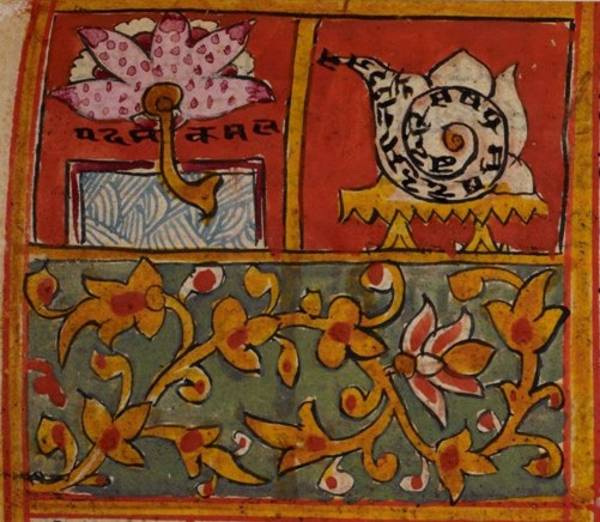
Plants and two-sensed beings
Image by British Library © CC0 1.0 (Creative Commons Public Domain)
The first vow that monks and nuns take on their initiation is the vow of non-violence. This vow expresses one of the main tenets of Jainism and is one of the key principles behind the four other vows new mendicants make.
The fundamental desire to minimise harm to all forms of life can be detected in many of the rules restraining the behaviour of mendicants. These rules relate to avoiding carelessness, which may cause unforeseen injury to living beings. The sub-microscopic nigodas and the tiny one-sensed life-forms – ekendriya – are particularly liable to be harmed by accident because they cannot be seen with the naked eye and live throughout the universe. For example, to minimise the harm done to water-bodied beings mendicants do not use water unnecessarily and drink only water that has been properly boiled.
Probably the most widely known example of the way that following this vow shapes the lives of mendicants is the ritual of seeking alms. Because obtaining and cooking food involves some degree of violence, monks and nuns do not prepare their own food. Instead they rely on lay people to provide food in the form of alms. The most visible instance of avoiding harm among some sects of the Śvetāmbara tradition is the white mouth-cloth worn by members of the Terāpantha and the Sthānaka-vāsins.
Limited vow of non-violence
Jains accept that avoiding accidental harm to all living beings is impossible for lay Jains. The activities of everyday life, such as working, cooking, eating, walking, washing, using tools and so on all involve violence, in that they harm one-sensed beings and nigodas. Lay Jains try to avoid causing more harm than they have to in the course of their ordinary lives but in some cases deliberate violence is allowed.
Householders generally try to minimise direct and indirect involvement in violence by eating a vegetarian diet and avoiding jobs and activities that involve great harm, such as mining. In Jain houses a cotton cloth is often tied to water-taps and used as a filter, to avoid accidentally drinking the single-sensed living beings in water. Providing food and other alms to mendicants entails a degree of violence on the part of lay people, but they gain merit – puṇya – from completing this religious duty. Thus they have an incentive to offer alms to mendicants, even though this duty involves violence in Jain eyes.
There are different levels of non-violence. Lay people are permitted to commit accidental – or even deliberate – violence if greater harm will come from not doing so. An example would be protecting vulnerable people from other people’s physical violence. Although this breaches the principle of non-violence, it is accepted that it is the lesser of two evils in certain situations.
2. Truth
The satya-vrata or vow of truth is the second vow in the list of five. It directs the vow-taker to always tell the truth, to never lie.
Lying is often done from passion, such as hatred or a wish to avoid embarrassment. Passions are a sign of attachment, which Jains believe should be conquered to advance spiritually towards liberation.
Telling only part of the truth is also considered to be a lie and is thus wrong.
Despite this, lay Jains can knowingly utter a falsehood if this stops a greater wrong. Mendicants must never tell a lie under any circumstances.
Absolute vow of truth
Monks and nuns vow to never say anything that is untrue. In some situations, lying may prevent harm to other living beings, but is not permitted. In this case saying nothing at all is the best action.
Limited vow of truth
Lay Jains are not supposed to tell lies, especially those from which they benefit or which harm others. This includes not telling the whole truth or taking part in dishonest business practices.
However, deliberately saying something false is permitted if this would prevent harm to another living creature.
Reading
- ‘Souper de jour: quatrains’
Nalini Balbir - Indologica Taurinensia: Professor Colette Caillat Felicitation Volume
volume 14
International Association of Sanskrit Studies; 1987–88
- ‘Lay Atonements: Investigation into the Śvetāmbara Textual Tradition’
Nalini Balbir - Prof. W. B. Bollée Felicitation Volume
edited by Peter Flügel
Routledge; London, UK; forthcoming
- ‘The “Sunday’s vow”: A Digambara Narrative of North India and its London Illustrated Manuscript’
Nalini Balbir - Sūrya-prabhā: Studies in Jainology – A Commemoration Volume in Honour of Ācārya 108 Śrī Sūrya Sāgara Jī Mahārāja
edited by Hampa Nagarajaiah, Arvind Kumar Singh and Navneet Kumar Jain
Acharya Shanti Sagar Chhani Smriti Granthamala; Muzaffarnagar, Uttar Pradesh, India; 2010
- Śrī parvakathādi vividha viṣaya saṃgraha
Muni Bhuvanavijaya - Bhinmal, Rajasthan, India; 1980
- ‘La Jñānapañcamīkathā de Maheśvarasūri’
Christine Chojnacki - Bulletin d’Études Indiennes
volume 15
Association Française pour les Études Indiennes; 1997
- Jains in the World: Religious Values and Ideology in India
John E. Cort - Oxford University Press USA; New York, USA; 2001
- The Jains
Paul Dundas - Library of Religious Beliefs and Practices series; series editor John Hinnels and Ninian Smart; volume 14
Routledge Curzon Press; London, UK; 2002
- ‘The role of the layman according to the Jain canon’
K. R. Norman - The Assembly of Listeners: Jains in Society
edited by Michael Carrithers and Caroline Humphrey
Cambridge University Press; Cambridge, UK; 1991
- Vrata-tithi-nirṇaya
Siṃhanandī - edited by Nemichandra Shastri
Jñānapīṭha-Mūrtidevī-Jaina-Granthamālā series; volume 19
Bhāratīya Jñānpīṭha; Kashi, Uttar Pradesh, India; 1956
- Commentary on Tattvārtha Sūtra of Vācaka Umāsvāti
Pandit Sukhlalji - translated by K. K. Dixit
L. D. series; volume 44
L. D. Institute of Indology; Ahmedabad, Gujarat, India; 1974
- Introduction to Sugandhadaśamī Kathā
A. N. Upadhye - edited by Hiralal Jain
Bhāratīya Jñānapīṭha; Delhi, India; 1966
- Historical Dictionary of Jainism
Kristi L. Wiley - Historical Dictionaries of Religions, Philosophies, and Movements series; series editor Jon Woronoff; volume 53
Scarecrow Press; Maryland, USA; 2004
- Jaina Yoga: A Survey of the Mediaeval Śrāvakācāras
Robert Williams - London Oriental series; volume XIV
Oxford University Press; London, UK; 1963
Links
- Five Great Monastic Vows
-
Pravin K. Shah writes about the Five Great Vows taken by Jain monks and nuns. The information is provided by the Jainism Literature Center, associated with the Faculty of Arts and Sciences at Harvard University.
http://www.fas.harvard.edu/~pluralsm/affiliates/jainism/jainedu/5greatvows.htm
- Twelve lay vows
-
Information about the 12 vows Jain lay people can take, provided by Pravin K. Shah on the website of the Jainism Literature Center, associated with the Faculty of Arts and Sciences at Harvard University.
http://www.fas.harvard.edu/~pluralsm/affiliates/jainism/jainedu/12vows.htm
- Lay vows
-
Digambara specialist Vilas Sangave has written this piece on the 12 lay vows for the Jainworld website.
- Jain doctrine
-
Jainworld.com gives a detailed explanation of key elements of Jain doctrine, including the:
- three gems
- concept of knowledge
- lay conduct
- vows
- penance.
- Jain ascetic
-
The Cleveland Museum of Art provides an unusual painting of a Jain monk carrying his mendicant equipment. Clad in white robes, the monk holds his alms bowl and a staff, which mark him out as a member of a Śvetāmbara Mūrti-pūjaka sect. Under his arm he carries his monastic broom and what may be a holy text. The Gujarati artist, Basawan, who worked for the Mughal Emperor Akbar, painted this picture around 1600, and its realistic treatment shows familiarity with European artistic styles.
- Mahāvīra renounces
-
This illustration is from a page of the Śvetāmbara scripture of the Kalpa-sūtra in the collections of the Philadelphia Museum of Art. It shows the last Jina, Mahāvīra, performing the rite of keśa-loca – ‘pulling out of the hair’ – which indicates indifference to the body. It is part of the initiation ceremony of dīkṣā, in which an initiate renounces the world and becomes a mendicant. He is watched by Śakra, king of the gods, who takes an active role in the lives of the 24 Jinas.
http://www.philamuseum.org/collections/permanent/105108.html?mulR=656|9
- Introduction to Jainism – part 4
-
This extract from a BBC documentary called The Frontiers of Peace explores the mendicant element of the traditional fourfold community. A man talks about his decision to stop being a Jain monk and return to the householder life, while a young woman fulfils her wish to becomes a nun. This 2010 YouTube video is the last of four parts. See the first part at: http://www.youtube.com/watch?v=IPscKFV5yKU
- Group initiation of Digambara monks – part 3
-
Towards the end of their group ceremony of renunciation – dīkṣā – 25 new Digambara monks have their heads anointed with sandalwood paste. The monk Vidyāsāgar, who is initiating them, traces the auspicious symbols of swastikas and four dots on their heads and palms. Then he blesses the new monks and newly initated novices – kṣullaka – who are dressed in white. He also consecrates their water pots – kamaṇḍalu. Both groups of mendicants hold their characteristic peacock-feather brooms – piñchī. Found on YouTube, this collective ceremony in Hindi took place on 21 August 2004 in the so-called Dayoday Tirth, Delwara Ghat, in the town of Jabalpur in Madhya Pradesh on the bank of the river Narmada. Watch the final part at http://www.youtube.com/watch?v=6QCfjoyWbLk
- New monks and nuns receive their names
-
During a Śvetāmbara Terāpanthin renunciation ceremony – dīkṣā – Ācārya Mahāshraman, the present leader of this order, reads out the names of the new nuns and monks. Since mendicants are considered to be new persons, new monks and nuns are always given new names. Performed in Hindi, this ceremony found on YouTube takes place in Rajasthan in September 2010.
- Śvetāmbara initation candidates in the crowd
-
As part of the renunciation ceremony to become a monk or nun – dīkṣā – the initiation candidates pass through a joyful crowd, who throw sandalwood powder over them. The initiates have already shaven and plucked out their hair and wear the white monastic robe of Śvetāmbara mendicants. This undated ceremony on YouTube takes place in Gujarat.
- +
- aAbhavya
- aAbhinandana
- aAbhiṣeka
- aĀcāra
- aĀcārāṅga-sūtra
- aĀcārya
- aAchalbhrata
- aAḍhāī-dvīpa
- aAdharma
- aAdho-loka
- aAdhyayana
- aAdvaita Vedānta
- aĀgama
- aAghātīya
- aAghātīya-karman
- aAgnibhuti
- aAgra
- aĀhāra
- aAhiṃsā
- aAhimsa Day
- aAjita
- aAjīva
- aAkampit
- aĀkāśa
- aAkbar the Great
- aAkṣaya-tṛtīyā
- aAlauddin Khalji
- aAlbert Einstein
- aAllah
- aAlms
- aĀlocanā
- aAloka-ākāśa
- aAmāri
- aAmbikā or Kūṣmāṇḍinī
- aAnagāra
- aAnanta
- aAnarthadaṇḍa
- aAnaśana
- aAnekānta-vāda
- aAṅga
- aAniconism
- aAnojjā
- aAntarāla
- aAntarāya-karma
- aAṇu
- aAṇu-vrata
- aAnukampā
- aAnuprekṣā
- aAnusvāra
- aApabhraṃśa
- aAparigraha
- aAra
- aĀrambha
- aĀrambhaja
- aĀratī
- aArdhamāgadhī Prākrit
- aArhaṃ
- aArhat
- aArśana-āvaraṇīya-karma
- aĀrta-dhyāna
- aĀryikā
- aĀryikā Jñānamati
- aĀśātanā
- aĀścarya
- aAscetic
- aAsceticism
- aAshram
- aAspiration
- aĀsrava
- aAṣṭa-maṅgala
- aAṣṭāpada
- aAstikāya
- aAstrolabe
- aAsura
- aAtheism
- aAticāra
- aAtiśayakṣetra
- aAtithisaṃvibhāgavrata
- aĀtma-vāda
- aĀtman
- aAuṃ
- aAurangzeb
- aAuspicious
- aAusterity
- aAvadhāna
- aAvadhi-jñāna
- aĀvaraṇī-yakarman
- aAvasarpiṇī
- aAvatāra
- aAvidyā
- aAxiom
- aĀyāga-paṭa
- aĀyambil
- aĀyu-karma
- aĀyurveda
- bBabur
- bBāhubali
- bBaladeva
- bBālāvabodha
- bBandha
- bBasadi
- bBazaar
- bBhadrankarvijay
- bBhagavant
- bBhaktāmara-stotra
- bBhakti
- bBhale
- bBharata
- bBhāṣā
- bBhāṣya
- bBhaṭṭāraka
- bBhāva
- bBhāva-pūjā
- bBhāvanā
- bBhavana-vāsin
- bBhavya
- bBhavyatva
- bBhaya
- bBhoga-bhūmi
- bBhogopabhoga
- bBodhi
- bBollywood
- bBrahmā
- bBrahma-deva
- bBrahmacārī
- bBrāhmaṇa
- bBraj Bhāṣā
- bBright fortnight
- bBritish Raj
- bBuddha
- bBuddhi-sagar
- bBuddhism
- bBuddhist
- cCaitya
- cCaityavāsin
- cCakravartin
- cCakreśvarī
- cCāmara
- cCandanā
- cCandragupta
- cCandraprabha
- cCanon
- cCāritra
- cCāritramohanīya-karman
- cCarũrī
- cCaste
- cCaturvidha-saṅgha
- cCaturviṃśati-stava
- cCāturyāma
- cCE
- cCelibacy
- cCha
- cChadmastha
- cChastity
- cCheda-sūtra
- cChristian
- cChristianity
- cClergy
- cCloning
- cColophon
- cCommentary
- cConch
- cConfession
- cCongregation
- cConsecration
- cCosmology
- cCremation
- cCrore
- cCult
- cCūrṇi
- dDādā-guru
- dDalit
- dDāna
- dDaṇḍa
- dDark fortnight
- dDarśana
- dDarśanamohanī-yakarman
- dDaśa-lakṣaṇa-parvan
- dDeity
- dDelhi Sultanate
- dDerāsar
- dDeśāvakāśika-vrata
- dDetachment
- dDevanāgarī
- dDevānandā
- dDevarddhi-gani
- dDevotee
- dDhamal
- dDhanuṣ
- dDhāra
- dDharma
- dDharma-dhyāna
- dDharma-sāgara
- dDharmastikaya
- dDhātakīkhaṇḍa
- dDholak
- dDhyāna
- dDiaspora
- dDig-vrata
- dDigambara
- dDīkṣā
- dDisciple
- dDīvālī
- dDivya-dhvani
- dDNA
- dDoctrine
- dDogma
- dDonor
- dDoṣa
- dDravya
- dDravya-pūjā
- dDrone
- dDuṣamā
- dDuṣamā-duṣamā
- dDuṣamā-suṣamā
- dDveṣa
- dDvīpa
- eEast India Company
- eEightfold Path
- eEkānta-vāda
- eEkendriya
- eElder
- eElders
- eEschatology
- eEtc up to
- fFarmān
- fFast
- fFatehpur Sikri
- fFestival
- fFestschrift
- fFiruz Shah
- fFly-Whisks
- fFolio
- fFour Noble Truths
- gGaccha
- gGaṇa
- gGaṇadhara
- gGanadharavada
- gGaṇeśa
- gGaṇin
- gGarba
- gGarbha
- gGarbha-gṛha
- gGaruḍa
- gGati
- gGene
- gGenomics
- gGhātī-yakarman
- gGhātīya
- gGhaznavid
- gGhiyasuddin Tughlaq
- gGhurid
- gGloss
- gGotra-karma
- gGujarāt
- gGujarati
- gGuṇa
- gGuṇa-sthāna
- gGuṇa-vrata
- gGupti
- gGuru
- gGuruṇī
- hHagiography
- hHajj
- hHaṃsa
- hHaribhadra
- hHariṇaigameṣin
- hHasta
- hHeresy
- hHiṃsā
- hHindi
- hHindu
- hHinduism
- hHīravijaya
- hHoroscope
- hHrīṃ
- hHumayun
- hHymn
- iIconoclasm
- iIconography
- iIdol
- iIndian Independence
- iIndology
- iIndra
- iIndrabhūti Gautama
- iIndriya
- iInitiation
- iIntercession
- iInvocation
- iIQ
- iIslam
- iIslamicate
- iIṣṭadevatā
- iĪśvara
- jJagat
- jJahangir
- jJain
- jJaina Devanāgarī
- jJaina Śaurasenī
- jJaina-dharma
- jJainaśāsana
- jJainness
- jJaisalmer
- jJamāli
- jJambū-dvīpa
- jJames Burgess
- jJanma
- jJanma-kalyāṇa
- jJarā
- jJāti
- jJina
- jJina-āgama
- jJina-bhavana
- jJina-bimba
- jJina-mātā
- jJinacandra-sūri
- jJinadatta
- jJinaprabha
- jJīva
- jJñāna
- jJñāna-āvaraṇīya-karma
- jJñāna-āvarṇiya
- jJñānsundar
- jJyotiṣka
- kKāla
- kKālakācārya-kathā
- kKālidāsa
- kKalpa-sūtra
- kKalpa-vṛkṣa
- kKalyāṇaka
- kKalyanvijay
- kKamaṇḍalu
- kKamaṭha
- kKarma
- kKarma-bhūmi
- kKarma-grantha
- kKarma-prakṛti
- kKarma-vāda
- kKarmon
- kKarnataka
- kKaṣāya
- kKathā
- kKāvya
- kKāya
- kKāyotsarga
- kKeśa-loca
- kKetu
- kKevala-jñāna
- kKevalin
- kKhalji
- kKharatara-gaccha
- kKnowledge
- kKriyā
- kKriyā-vāda
- kKṛṣṇa
- kKṣamā-śramaṇa
- kKṣapakaśreṇi
- kKṣatriya
- kKṣullaka
- kKulakara
- kKundakunda
- kKunthu
- lLabdhi
- lLaity
- lLakh
- lLāñchana
- lLands of Action
- lLaukāntika
- lLavaṇa-samudra
- lLeśyā
- lLiṅga
- lLinguistics
- lLoka
- lLoka-ākāśa
- lLoka-puruṣa
- lLoka-vāda
- lLotus
- lLotus lake
- mMadhya-loka
- mMahā-videha
- mMahā-vrata
- mMahābhārata
- mMahāmastakābhiṣeka
- mMāhārāṣṭra
- mMāhārāṣṭrī Prākrit
- mMahattarā Yākinī
- mMahāvīr Jayantī
- mMahāvīra
- mMakāra
- mMakkhali Gośāla
- mMalli
- mMāna-stambha
- mManaḥ-paryāya-jñāna
- mMaṇḍala
- mMaṇḍapa
- mMandit
- mMaṅgala
- mMantra
- mMantras
- mManuṣya-loka
- mMarāṭhī
- mMārgaṇā
- mMartyr
- mMarudevī
- mMaṭha
- mMati-jñāna
- mMauryaputra
- mMecca
- mMendicant lineage
- mMetarya
- mMiracle
- mMithyādṛṣṭi
- mMohandas Gandhi
- mMohanīya-karma
- mMokṣa
- mMonastic order
- mMonasticism
- mMonk
- mMonotheism
- mMosque
- mMount Meru
- mMount Sammeta
- mMṛgāvatī
- mMughal
- mMuhammad
- mMuhammad bin Tughlaq
- mMuhpattī
- mMūla-sūtra
- mMūlaguṇa
- mMumbaī
- mMuni
- mMunisuvrata
- mMurad Bakhsh
- mMūrti-pūjaka
- mMuslim
- mMysticism
- nNābhi
- nNāga-kal
- nNāgapurīya Tapā-gaccha
- nNāgarī
- nNāma-karma
- nNamaskāra-mantra
- nNami
- nNandīśvara-dvīpa
- nNandivardhana
- nNandyāvarta
- nNāraka
- nNāraki
- nNasalisation
- nNātha
- nNavrātrī
- nNaya-vāda
- nNemi
- nNidāna
- nniggaṃthāṇa vā 2
- nniggaṃtho vā 2
- nNigoda
- nNihnava
- nNikṣepa
- nNirgrantha
- nNirjarā
- nNirvāṇa
- nNiryukti
- nNiṣidhi
- nNitya
- nNiyati
- nNo-kaṣāya
- nNudity
- nNun
- oOcean of milk
- oOmniscience
- oOrdination
- ppa°
- pPadmaprabha
- pPadmāsana
- pPadmāvatī
- pPādukā
- pPalanquin
- pPalette
- pPañca-muṣṭi
- pPāṇḍava
- pPaṇḍit
- pPandit Dalsukh D. Malvania
- pPandit Sukhlalji
- pPāṇipātra
- pPāpa
- pParamātman
- pParameṣṭhin
- pPāraṇā
- pParigraha
- pPariṇāma
- pParīṣaha
- pParokṣa
- pPārśva
- pPārśvanātha
- pParyāya
- pParyuṣaṇ
- pPaṭa
- pPatan
- pPātra
- pPenance
- pPersian
- pPhala
- pPhilology
- pPicchikā
- pPilgrimage
- pPīr
- pPolymath
- pPoṣadha
- pPossession
- pPothī
- pPrabhas
- pPradakṣiṇā
- pPradeśa
- pPrākāra
- pPrakīrṇaka-sūtra
- pPrākrit
- pPramāda
- pPramukhā
- pPrati-vāsudeva
- pPratikramaṇa
- pPratimā
- pPratiṣṭhā
- pPratyākhyāna
- pPratyakṣa
- pPravacana
- pPrāyaścitta
- pPrayer
- pPre-modern
- pPreach
- pPredestination
- pProtestant
- pProvenance
- pPudgala
- pPūjā
- pPujārī
- pPukharavara-dvīpa
- pPuṇya
- pPūrva
- pPuṣkara-dvīpa
- pPuṣpadanta
- pPyre
- qQur’an
- rRāga
- rRāhu
- rRainy season
- rRajasthan
- rRajasthani
- rRājimatī
- rRajoharaṇa
- rRajput
- rRāma
- rRāmāyaṇa
- rRangoli
- rRās-garbā
- rRasa
- rRathanemi
- rRatna-traya
- rRātri-bhojana
- rRaudra-dhyāna
- rRecto
- rRelic
- rRenunciation
- rRetroflex
- rRevatī
- %Ṛg-veda
- rRite
- rRosary
- %Ṛṣabha
- %Ṛṣabhanātha
- rRupee
- sSaciyā Mātā
- sSādhu
- sSādhvī
- sSāgāra
- sSaint
- sŚaivaism
- sŚaka-saṃvat
- sSallekhanā
- sŚalya
- sSamacatuṣṭha
- sSamādhimaraṇa
- sSamaṇi
- sSāmarambha
- sSamavasaraṇa
- sSāmāyika
- sSaṃbhava
- sSamiti
- sSaṃjñā
- sSaṃkalpaja
- sSaṃsāra
- sSamudghāta
- sSaṃvara
- sSaṃvega
- sSamyak-cāritra
- sSamyak-darśana
- sSamyak-jñāna
- sSamyaktva
- sSaṃyama
- sSanctuary
- sSandalwood
- sSaṇgha
- sSanskrit
- sSant
- sŚānti
- sSapta-bhaṅgi-naya
- sSārambha
- sSarasvatī
- sSarvajña
- sSāsan-devi
- sŚāsana-devatā
- sŚāstra
- %Ṣaṭ-jīvanikāya
- sSatī
- sSatīmātā
- sSatya
- sSchism
- sScribe
- sScripture
- sSect
- sSecularism
- sŚenāī
- sSermon
- sŚeṣavatī
- sSevā
- sSeven fields of donation
- sShah Jahan
- sShantidas Jhaveri
- sShrine
- sSiddha
- sSiddha-śilā
- sSiddhacakra or Navadevatā
- sSiddhānta
- sSiddhārtha
- sSiddhi
- sSikh
- sSikhism
- sŚikṣā-vrata
- sŚīla
- sSin
- sSindh
- sŚītala
- sŚiva
- sSkandha
- sSomanatha
- sŚraddhā
- sŚramaṇa
- sŚrāvaka
- sŚrāvakācāra
- sŚrāvikā
- sŚreyāṃsa
- sŚrī
- sŚrīvatsa
- sŚruta-jñāna
- sŚruta-pañcamī
- sSthānaka-vāsin
- sSthāpanācārya
- sSthāvara
- sSthavira
- sSthiti
- sStrīmukti
- sStūpa
- sSubcontinent
- sSudarshana
- sŚuddhi
- sSudharma
- sŚūdra
- sSufism
- sSukha
- sŚukla-dhyāna
- sSulasā
- sSultan
- sSumati
- sSundarśrī
- sSupārśva
- sSūri
- sSuṣamā
- sSuṣamā-duṣamā
- sSuṣamā-suṣamā
- sSūtra
- sSuyam me ausam! Tenam bhagavaya evamakkhayam
- sSvādhyāya
- sSvāhā
- sSvastika
- sŚvetāmbara
- sŚvetāmbara Terāpanthin
- sŚvetāmbaras
- sSwan
- sSyād-vāda
- tTabla
- tTantra
- tTapā-gaccha
- tTapas
- tTāraṇ Svāmī Panth
- tTattva
- tTattvārtha-sūtra
- tTemple
- tTemple-city
- tThe Enlightenment
- tTheology
- tThree worlds
- %Ṭīkā
- tTilaka
- tTīrtha
- tTīrthaṃkaranāma-karman
- tTīrthankara
- tTransliteration
- tTrasa
- tTrasa-nāḍī
- tTriśalā
- tTriṣaṣṭi-śalākā-puruṣa-caritra
- tTti bemi
- tTughlaq
- tTunk
- uUdumbara
- uUniversal History
- uUpādhyāya
- uUpāṅga
- uUpaniṣads
- uUpāsaka
- uUpasarga
- uUpāśraya
- uŪrdhva-loka
- uUtsarpiṇī
- uUttarādhyayana-sūtra
- vVāhana
- vVaimānika
- vVairāgya
- vVaiṣṇava
- vVaiśramaṇa
- vVaiśya
- vValabhī
- vVanaspatikāya
- vVandana
- vVaṇik
- vVarṇa
- vVāsudeva
- vVāsupūjya
- vVayubhūti
- vVeda
- vVedanīya-karma
- vVegetarianism
- vVehicle
- vVernacular
- vVerso
- vVidyā
- vVidyā-devī
- vVihāra
- vVijñapti-patra
- vVikrama-saṃvat
- vVikṛti
- vVimala
- vVinaya
- vVipāka
- vVirji Vora
- vVirodhaja
- vVīrya
- vVisarga
- vViṣṇu
- vVītarāga
- vVizier
- vVotive
- vVow
- vVrata
- vVS
- vVyakta
- vVyantara
- vVyasana
- yYakṣa
- yYakṣī
- yYantra
- yYaśoda
- yYaśovijaya
- yYati
- yYātrā
- yYoga
- yYoginī
- yYojana



